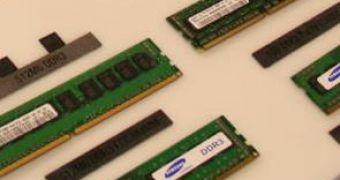Samsung showed their GDDR4 and DDR3 memory modules inside IDF Technology Showcase pavilion. The DIMMs were packed in 1GB modules, and the memory was actually running on Intel's Test Platform, containing next-generation Intel Bearlake chipset (probably will end up branded as i985X or i995X). But what was most impressive was the fact that the memory was running and looping 3DMark06 all the time, according to a reporter from The Inquirer.
Also, the company representatives talked about the specs and possible clock-speeds of both DDR3 and GDDR4 - the DDR3 starts at 800 MHz and goes up to 1.6GHz, while GDDR4 is starting at 1GHz DDR (2GHz) and ending all the way at 2.2-2.4 GHz DDR (4-4.8 GHz), which will yield in pretty incredible bandwidth numbers, especially in the graphics arena. DDR3 modules are ready in typical DIMM, Universal DIMM and SO-DIMM packaging, so all of the platforms will be supported from day one.
Asked upon a possibility of seeing GDDR4 as the system memory, Samsung's engineer gave a different answer to the one received from members of Intel's FB-DIMM camp. Basically, the biggest issue of seeing GDDR4 becoming a system memory isn't its orientation towards graphic processors, but rather an issue of thermal nature. GDDR4 would consume far more power than the companies are able to push through the DIMMs.
This happens after Micron announced that it has begun sampling for 1 GB DDR 3 and has 2 GB chips in development. The specs for their memories: 1600 MT/s at 800 Mhz (doubling DDR 2 performance), memory voltage reduced from 1.8 V to 1.5 V and power consumption reduced by 30%, manufactured using 78 nm technology. Also, they support JEDEC DDR 3 specs and densities are expected to be between 512 MB and 4 GB, with FBDIMM, UDIMM, SODIMM and RDIMM modules.

 14 DAY TRIAL //
14 DAY TRIAL //